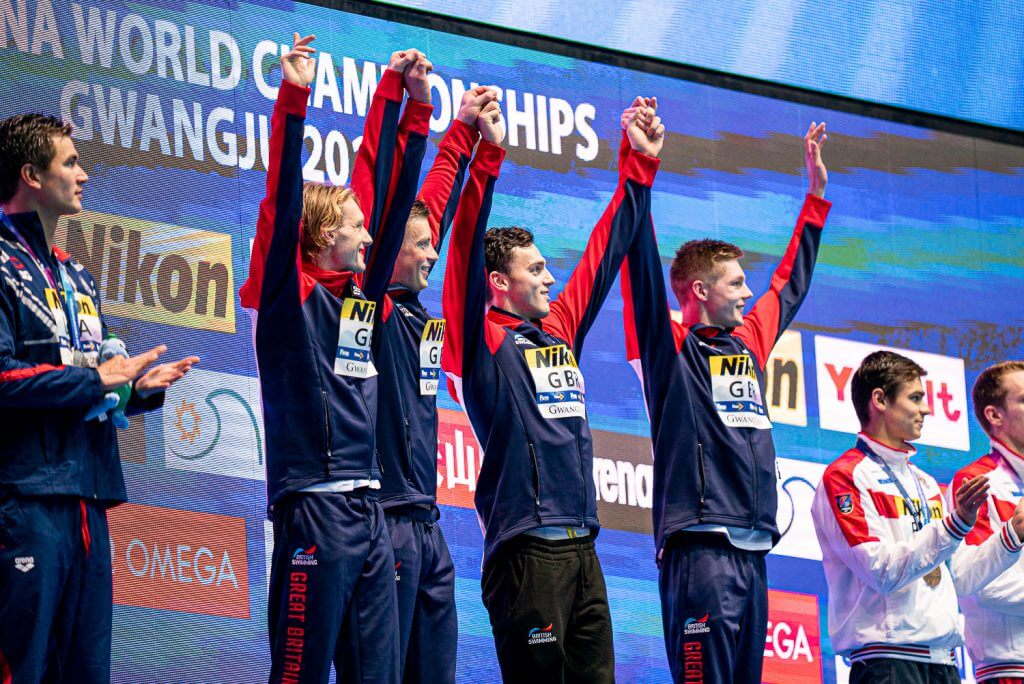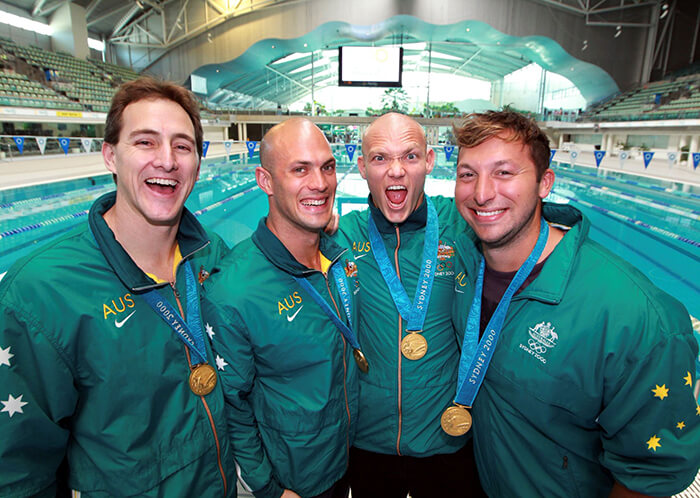Relays Rule: Why These Team Events Elevate Excitement In the Sport

Relays Rule: Why These Team Events Elevate Excitement In the Sport
By Josie Wise, Swimming World Intern
From the famous 4×100 freestyle relay with Jason Lezak in Beijing all the way to a tiny high school showdown, relay swims are capable of getting an entire natatorium of people screaming at the top of their lungs. Anyone who has been witness to one of these swimming events knows that gut-wrenching anticipation, stomach full of wild butterflies, and ultimate exhilaration that comes with seeing which swimmer will get their hand to the wall first. There are close calls in every event in swimming, but none seem to consistently elicit the response of a relay. So what differentiates relay races and individual swims for a crowd?
Rivalries
Like with any competition, there are always deep-rooted rivalries between competitors. At the Olympic level, these can run deep and be huge motivating factors for teams and spectators. Furthermore, the swims that can truly rile up a crowd are those that motivate people to cheer for swimmers that aren’t on their own teams. That can be one of the magical effects of relays. Spectators may be more likely to cheer for a team that’s somewhat of an underdog, or one that’s competing to defeat an opponent that has one way or another come to be known as the “bad guys.”

Photo Courtesy: Swimming World Magazine
In the 1976 Olympic Games, there were rumors circulating that the East Germans were doping; and though the rumors weren’t confirmed until later, it sparked the women’s 4×100 freestyle relay to become a legendary race. The United States, led by Shirley Babashoff, had not been expected to win but ended up seizing both the world record and gold medal over the East Germans. When watching the video of the race, you can hear the commentator begin to yell along with the screaming crowd. It’s easy to see for yourself why this race ranks as one of the most thrilling relays ever.
While this example is on the largest scale possible in the sport, that’s not to say it doesn’t occur at the smaller levels. High school state meets are places where school rivalries can kick up some racket. College conference meets and NCAAs are also chock-full of historic feuds. Anywhere you go in the sport, there are bound to be favorites and underdogs, good guys and bad guys. Relays are sometimes the sole chance for those to come under the spotlight.
The Fresh Leg
The most obvious difference between a relay and an individual swim could also be looked at as another reason for relay excitement: there are four people on a relay and only one in individual events. Each new person that leaps into the water could twist the competition in an entirely different way. It could seem that one team has a commanding lead, but once two new swimmers are in the water, it’s a completely different race.
Imagine yourself sitting in the stands on the fifth night of finals at a long meet. You’re watching your team’s relay swim in the last event, and don’t expect much because they aren’t meant to win. The first people dive in, and everything is how it should be with your team a few lengths behind. Then the next person jumps in and gets a little bit of a lead. Your heart jumps – maybe you’ll win this after all! But the third leg dives in and your heart sinks as they fall behind again. And then, the final swimmers dive into the water. The tides change again. Suddenly, you’re on your feet with the rest of your team, throat going hoarse, ears ringing with the noise of the natatorium. Before you know it, your anchor has touched the wall first and delivered the unexpected. After the roller coaster of a race, as you celebrate with your team, you find yourself appreciating the wild magic of relays.
The 400 Freestyle Relay

Michael Klim and the gold-medal Australian Relay team at the 2000 Sydney Olympics
There are many different relays in swimming, but it would be a shame to not acknowledge perhaps the most monumental one. The 400 freestyle relay is commonly set to be the last event of the competition in many meet formats. This last race can act as the swimming equivalent of the final few seconds of a basketball game where teams are tied, or when a football player is just yards away from scoring a winning touchdown. In swimming, when the meet has come down to just a few points between teams, the 400 free relay can be the deciding factor of who wins. It isn’t hard to picture the pure excitement in a natatorium at this point in a meet.
Whether you’re an athlete in a relay cheering on your teammates from behind the blocks and letting the adrenaline fuel you in the water, or simply an ecstatic spectator, relays are the culmination of everything great about swimming. They bring out the best in competitors. They allow the sometimes squandered team aspect of the sport to truly shine. And most importantly, they’re just really fun. So the next time you’re watching a swim meet (possibly the Olympics!) with some exciting relays, don’t be afraid to get on your feet and cheer.
All commentaries are the opinion of the author and do not necessarily reflect the views of Swimming World Magazine nor its staff.




Relays Rock!
JOSIE! Very good article. Thank you.
Great article Josie!
Great Job on the article!
You captured the best of relays and got my heart pumping. I also love how relays require four swimmers to achieve synergy by focusing on a singular goal, as well as the risky yet fun skill of relay exchanges.